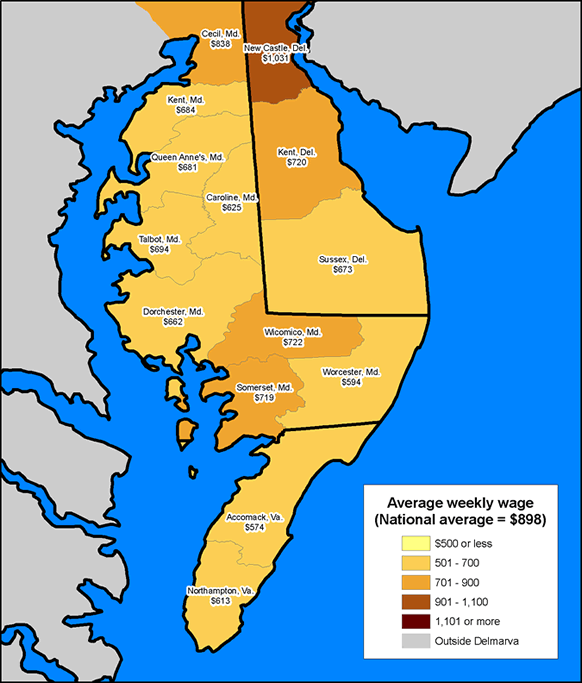| Internet: www.bls.gov/ro3/ | PLS - 4439 FOR RELEASE: TUESDAY, AUGUST 26, 2008 |
|||||||||||||||||||||||||||||||||||||||||||||||||||||||||||||||||||||||||||||||||||||||||||||||||||
| INFORMATION: | Gerald Perrins (215) 597-3282 |
|||||||||||||||||||||||||||||||||||||||||||||||||||||||||||||||||||||||||||||||||||||||||||||||||||
| MEDIA CONTACT: | Sheila Watkins (215) 861-5600 |
|||||||||||||||||||||||||||||||||||||||||||||||||||||||||||||||||||||||||||||||||||||||||||||||||||
Employment and Wages on the Delmarva Peninsula: Fourth Quarter 2007 (PDF)Workers on the Delmarva Peninsula1 earned an average of $855 per week in the fourth quarter of 2007 according to Quarterly Census of Employment and Wages (QCEW) published by the Bureau of Labor Statistics of the U.S. Department of Labor. Sheila Watkins, the Bureau’s regional commissioner, noted that while the wages were highest in the two counties on the peninsula that are part of the Wilmington, Del.-N.J.-Md. Metropolitan Division—New Castle, Del. ($1,031) and Cecil, Md. ($838), only New Castle’s average weekly wage was higher than the national average of $898. Employment in December 2007 was also highest in New Castle (289,094); the county accounted for close to 50 percent of the employed on the peninsula.  (See table A.)
Delmarva’s fourth quarter 2007 average weekly wage was $43 below the national average. Thirteen of the 14 counties on the Delmarva Peninsula had lower-than-average weekly wages, ranging from $574 to $838. Accomack, Va., had the lowest wages at $574, followed by Worcester, Md., at $594 and Northampton, Va., at $613. These three counties, located on the southeastern part of the peninsula, had wages that were 32 percent or more below the U.S. average.  Nine of the counties on the peninsula registered wages under $700, three had wages from $701 to $800, and only two had wages above $800.  (See chart 1.) In December 2007, 616,377 workers were employed on the Delmarva Peninsula with almost 70 percent of them working in Delaware’s 3 counties, about 28 percent in the Maryland counties and less than 3 percent in the Virginia counties.  With the exception of New Castle, none of the other 13 counties had an employment level exceeding 70,000, though 4 employed over 30,000 workers: Sussex, Del., Kent, Del., Wicomico, Md., and Cecil, Md. The county with the fewest jobs was at the southern tip—Northampton, Va., with 4,994 workers. Maryland’s southernmost county, Somerset, was next with 7,204. Other counties employing fewer than 10,000 workers were Kent, Md. (8,545), and Caroline, Md. (8,793). Average weekly wage data by county are compiled under the Quarterly Census of Employment and Wages (QCEW) program, also known as the ES-202 program. The data are derived from summaries of employment and total pay of workers covered by state and federal unemployment insurance (UI) legislation and provided by State Workforce Agencies (SWAs). The 9.1 million employer reports cover 137.0 million full- and part-time workers. The average weekly wage values are calculated by dividing quarterly total wages by the average of the three monthly employment levels of those covered by UI programs. The result is then divided by 13, the number of weeks in a quarter. It is to be noted, therefore, that over-the-year wage changes for geographic areas may reflect shifts in the composition of employment by industry, occupation, and such other factors as hours of work. Thus, wages may vary among counties, metropolitan areas, or states for reasons other than changes in the average wage level. Data for all states, Metropolitan Statistical Areas (MSAs), counties, and the nation are available on the BLS Web site at www.bls.gov/cew/; however, data in QCEW press releases have been revised (see Technical Note below) and may not match the data contained on the Bureau’s Web site. Additional statistics and other informationAn annual bulletin, Employment and Wages, features comprehensive information by detailed industry on establishments, employment, and wages for the nation and all states. The 2006 edition of this bulletin contains selected data produced by Business Employment Dynamics (BED) on job gains and losses, as well as selected data from the first quarter 2007 version of this news release. As with the 2005 edition, this edition includes the data on a CD for enhanced access and usability with the printed booklet containing selected graphic representation of QCEW data; the data tables themselves are published exclusively in electronic formats as PDF. The 2006 bulletin is available in a PDF on the BLS Web site at www.bls.gov/cew/cewbultn06.htm. Information in this release will be made available to sensory impaired individuals upon request. Voice phone: 202-691-5200; TDD message referral phone number: 1-800-877-8339. For personal assistance or further information on the Quarterly Census of Employment and Wages Program, as well as other Bureau programs, contact the Mid-Atlantic Information Office at 215-597-3282 from 8:30 a.m. to 12:00 p.m. and 1:00 p.m. to 3:30 p.m. ET. Technical NoteQCEW data are not designed as a time series. QCEW data are simply the sums of individual establishment records reflecting the number of establishments that exist in a county or industry at a point in time. Establishments can move in or out of a county or industry for a number of reasons--some reflecting economic events, others reflecting administrative changes. The preliminary QCEW data presented in this release may differ from data released by the individual states as well as from the data presented on the BLS Web site. These potential differences result from the State’s continuing receipt, review and editing of UI data over time. On the other hand, differences between data in this release and the data found on the BLS Web site are the result of adjustments made to improve over-the-year comparisons. Specifically, these adjustments account for administrative (noneconomic) changes such as a correction to a previously reported location or industry classification. Adjusting for these administrative changes allows users to more accurately assess changes of an economic nature (such as a firm moving from one county to another or changing its primary economic activity) over a 12-month period. Currently, adjusted data are available only from BLS press releases.Â
|
||||||||||||||||||||||||||||||||||||||||||||||||||||||||||||||||||||||||||||||||||||||||||||||||||||
Chart 1. Average weekly wages by county on the Delmarva Peninsula, fourth quarter 2007

Last Modified Date: August 26, 2008

